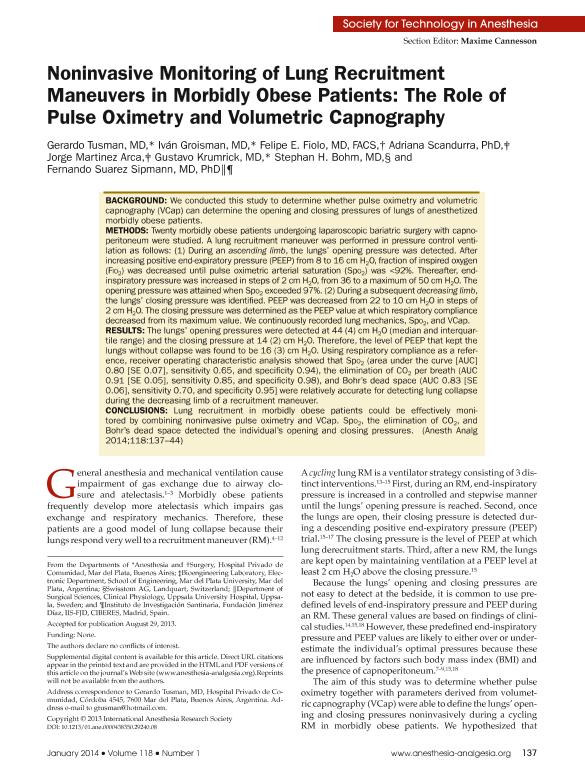Mostrar el registro sencillo del ítem
dc.contributor.author
Tusman, Gerardo
dc.contributor.author
Groisman, Iván
dc.contributor.author
Fiolo, Felipe E.
dc.contributor.author
Scandurra, Adriana
dc.contributor.author
Martinez Arca, Jorge

dc.contributor.author
Krumrick, Gustavo
dc.contributor.author
Bohm, Stephan H
dc.contributor.author
Suarez-sipmann, Fernando
dc.date.available
2016-02-26T16:33:51Z
dc.date.issued
2013-08-29
dc.identifier.citation
Tusman, Gerardo; Groisman, Iván; Fiolo, Felipe E.; Scandurra, Adriana; Martinez Arca, Jorge; et al.; Noninvasive monitoring of lung recruitment maneuvers in morbidly obese patients: the role of pulse oximetry and volumetric capnography; Lippincott, Williams; Anesthesia And Analgesia; 118; 1; 29-8-2013; 137-144
dc.identifier.issn
0003-2999
dc.identifier.uri
http://hdl.handle.net/11336/4460
dc.description.abstract
BACKGROUND: We conducted this study to determine whether pulse oximetry and volumetric capnography (VCap) can determine the opening and closing pressures of lungs of anesthetized morbidly obese patients.
METHODS: Twenty morbidly obese patients undergoing laparoscopic bariatric surgery with capnoperitoneum were studied. A lung recruitment maneuver was performed in pressure control ventilation as follows: (1) During an ascending limb, the lungs? opening pressure was detected. After increasing positive end-expiratory pressure (PEEP) from 8 to 16 cm H2O, fraction of inspired oxygen (FIO2) was decreased until pulse oximetric arterial saturation (SpO2) was <92%. Thereafter, end-inspiratory pressure was increased in steps of 2 cm H2O, from 36 to a maximum of 50 cm H2O. The opening pressure was attained when SpO2 exceeded 97%. (2) During a subsequent decreasing limb, the lungs? closing pressure was identified. PEEP was decreased from 22 to 10 cm H2O in steps of 2 cm H2O. The closing pressure was determined as the PEEP value at which respiratory compliance decreased from its maximum value. We continuously recorded lung mechanics, SpO2, and VCap.
RESULTS: The lungs' opening pressures were detected at 44 (4) cm H2O (median and interquartile range) and the closing pressure at 14 (2) cm H2O. Therefore, the level of PEEP that kept the lungs without collapse was found to be 16 (3) cm H2O. Using respiratory compliance as a reference, receiver operating characteristic analysis showed that SpO2 (area under the curve [AUC] 0.80 [SE 0.07], sensitivity 0.65, and specificity 0.94), the elimination of CO2 per breath (AUC 0.91 [SE 0.05], sensitivity 0.85, and specificity 0.98), and Bohr's dead space (AUC 0.83 [SE 0.06], sensitivity 0.70, and specificity 0.95] were relatively accurate for detecting lung collapse during the decreasing limb of a recruitment maneuver.
CONCLUSIONS: Lung recruitment in morbidly obese patients could be effectively monitored by combining noninvasive pulse oximetry and VCap. SpO2, the elimination of CO2, and Bohr's dead space detected the individual's opening and closing pressures.
dc.format
application/pdf
dc.language.iso
eng
dc.publisher
Lippincott, Williams

dc.rights
info:eu-repo/semantics/openAccess
dc.rights.uri
https://creativecommons.org/licenses/by-nc-sa/2.5/ar/
dc.subject
Pulse Oximetry
dc.subject
Data Processing
dc.subject
Ventilation Strategies
dc.subject
Lung Recruitment Maneuvers
dc.subject.classification
Anestesiología

dc.subject.classification
Medicina Clínica

dc.subject.classification
CIENCIAS MÉDICAS Y DE LA SALUD

dc.title
Noninvasive monitoring of lung recruitment maneuvers in morbidly obese patients: the role of pulse oximetry and volumetric capnography
dc.type
info:eu-repo/semantics/article
dc.type
info:ar-repo/semantics/artículo
dc.type
info:eu-repo/semantics/publishedVersion
dc.date.updated
2016-03-30 10:35:44.97925-03
dc.journal.volume
118
dc.journal.number
1
dc.journal.pagination
137-144
dc.journal.pais
Estados Unidos

dc.journal.ciudad
Philadelphia
dc.description.fil
Fil: Tusman, Gerardo. Fundacion Medica de Mar del Plata. Hospital Privado de Comunidad; Argentina
dc.description.fil
Fil: Groisman, Iván. Fundacion Medica de Mar del Plata. Hospital Privado de Comunidad; Argentina
dc.description.fil
Fil: Fiolo, Felipe E.. Fundacion Medica de Mar del Plata. Hospital Privado de Comunidad; Argentina
dc.description.fil
Fil: Scandurra, Adriana. Universidad Nacional de Mar del Plata. Facultad de Ingeniería; Argentina
dc.description.fil
Fil: Martinez Arca, Jorge. Universidad Nacional de Mar del Plata. Facultad de Ingeniería; Argentina. Consejo Nacional de Investigaciones Científicas y Técnicas. Centro Científico Tecnológico Mar del Plata. Instituto de Investigación en Ciencia y Tecnología de Materiales (i); Argentina
dc.description.fil
Fil: Krumrick, Gustavo. Fundacion Medica de Mar del Plata; Argentina
dc.description.fil
Fil: Bohm, Stephan H. Swisstom AG; Suiza
dc.description.fil
Fil: Suarez-sipmann, Fernando. Instituto de Investigación Santinaria. Fundación Jiménez Díaz; España
dc.journal.title
Anesthesia And Analgesia

dc.relation.alternativeid
info:eu-repo/semantics/altIdentifier/ark/10.1213/01.ane.0000438350.29240.08
dc.relation.alternativeid
info:eu-repo/semantics/altIdentifier/ark/http://journals.lww.com/anesthesia-analgesia/Fulltext/2014/01000/Noninvasive_Monitoring_of_Lung_Recruitment.16.aspx
dc.relation.alternativeid
info:eu-repo/semantics/altIdentifier/doi/http://dx.doi.org/10.1213/01.ane.0000438350.29240.08
Archivos asociados
